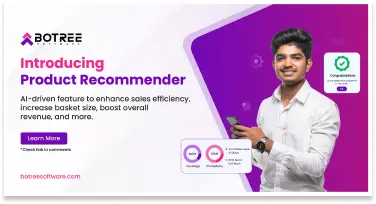
Power Your Sales Growth with Smarter Approvals, Real-Time Insights, & Complete Control with DMS 2.19 Update
Power Your Sales Growth with Smarter Approvals, Real-Time Insights, &

Power Your Sales Growth with Smarter Approvals, Real-Time Insights, &

Introducing the AI-Driven Product Recommender to Maximize Basket Size at Every Outlet
We are thrilled to introduce our latest innovation, the Product Recommender, designed to transform the way businesses optimize their product offerings and enhance sales productivity.

In retail, the difference between strategy and execution often determines who leads in the market. Brands can take months to create the perfect merchandising plan. However, if execution fails at the store level, the strategy loses its effectiveness. Shoppers pay attention to what they see, can reach, and what looks good on the shelf—not what’s written in a strategy document.
Visual merchandising directly influences buying behaviour. Research shows that many purchase decisions happen inside the store, often in less than a minute. This means your products need to be visible, well-placed, and consistent with brand guidelines all the time. Any inconsistency, such as out-of-stock shelves, incorrect product placement, or missing promotional material, leads to missed chances.
This is where Botree becomes an essential partner for brands. With decades of experience in retail technology, Botree Software has developed solutions that connect merchandising strategy to effective execution. By linking sales teams, distributors, and retailers on a single platform, ensuring that execution is handled carefully and responsibly.
Brands invest significantly in visual merchandising. From planograms to campaign designs, they dedicate countless hours and resources to planning product displays on the shelf. However, when it comes to execution at the store level, the results often fail to meet expectations. The problem isn’t the strategy; it’s the execution.
Research shows that merchandising initiatives fail due to poor in-store execution. Another study reveals that one in three shoppers leave without purchasing simply because they can’t see or find the product. These issues directly impact revenue, brand image, and retailer relationships.
Even with clear guidelines, shelf execution often varies by store. Products intended for eye-level placement or grouped by category often end up in the wrong spots. This reduces visibility and undermines the effort put into shelf strategy. Research indicates that products placed at eye level can sell up to 35% more than those on lower shelves. Each misplaced item represents a lost sales opportunity.
A product may exist in the warehouse or with distributors but may never reach the shelf in time. Stock-outs lead to an average of 4% in lost sales globally. In high-demand categories, this figure can rise. Moreover, many consumers switch brands immediately if they can’t find what they want, resulting in direct market share loss.
Audits are essential for understanding compliance at the store level. However, manual audits often take days or weeks to finalize. By the time insights are available to decision-makers, the campaign or promotion may have already ended. Studies show that traditional audits typically achieve only 60–70% accuracy, leaving significant gaps for brands.
Field sales teams should drive growth, but they often spend a large part of their day on paperwork, manual compliance checks, and reporting. This limits their time for selling and leads to inconsistent data quality. Many brands lose field time to administrative tasks, which cuts into productivity.
Retailers play a vital role in execution. Without clear information on campaigns, promotions, or planograms, they often implement merchandising inconsistently. This leads to uneven brand visibility across stores, despite the brand’s significant investments.
Traditional merchandising methods struggle to keep up with the complexities of modern retail.
As a result, merchandising strategies may appear effective on paper but often fall short in practice. Retailers lose trust, shoppers turn to competitors, and brands experience declining returns on their merchandising investments.
These statistics highlight the urgent need for brands to change their approach. Execution cannot be left to chance. It requires structured workflows, real-time tracking, and technology that guarantees compliance at every retail touchpoint.
Conduct weekly compliance checks instead of monthly audits. Smaller, frequent checks help detect and fix merchandising gaps faster.
One of the biggest concerns brands have when adopting new retail technology is the complexity of implementation. Long timelines, high training costs, and integration challenges often delay ROI. Botree Software removes these barriers by offering a smooth, step-by-step deployment process that works with your existing systems.
With Botree Software, adopting technology is not a painful overhaul. It is a smooth transition that delivers results faster, with systems your teams use and trust.
Start with one module (e.g., SFA) and scale gradually. Modular adoption reduces disruption while showing early wins.
Botree Software connects distributors, sales teams, and retailers on one platform. This ensures that merchandising strategies lead to consistent shelf execution across every outlet.
Supervisors track compliance in real time. They correct issues like misplaced SKUs or missing signs instantly. Compliance checks are up to 25% faster than manual audits.
Sales reps receive reminders about missing products, target SKUs, and campaign priorities. Leaderboards improve field performance and consistency.
Outlet visits are tracked accurately. This prevents false reporting and ensures that store-level execution remains consistent.
Sales team see live schemes and campaigns while placing orders, ensuring that promotions reach shelves on time.
Teams gather competitor data at the outlet, and managers quickly address any gaps.
Managers monitor planogram adherence, campaign performance, and stock risks instantly. They correct issues before they escalate.
Manual methods are slow, inaccurate, and reactive. Competitor tools focus narrowly on order booking or inventory, leaving merchandising gaps.
Botree provides complete control from stock planning to shelf execution, trusted by leading FMCG brands.
Clients report a 37.5% increase in field productivity and faster outlet expansion.
Nabati India adopted Botree SFA and DMS to improve visibility and streamline field execution. Features like real-time SKU suggestions, route optimization, and scheme visibility gave reps powerful tools.
Impact: Sales team productivity increased by 37.5%, assortment per outlet grew, and direct distribution expanded faster than competitors.
Visual merchandising success depends on flawless execution. Strategy alone isn’t enough. Shelves must stay stocked, displays must follow guidelines, and promotions must activate on time. Gaps at any stage can lead to lost sales and a weaker brand impact.
Botree makes sure this doesn’t happen. With its integrated suite of Botree SFA, DMS, Retailer App, and AI-driven insights, brands gain complete control over execution. From distributors to sales reps to retailers, everyone works on one platform. The outcome is consistent compliance, stronger retailer engagement, and measurable growth in every market.
Partner with Botree Software to make sure your merchandising plans succeed where it matters most, at the shelf.
Meet Christina Evangelin Ebinezer, our dynamic marketing associate at Botree Software. With a background in HR and marketing, and prior experience as a content writer, Christina brings a sharp eye for storytelling and a knack for crafting engaging blogs and marketing content. She’s passionate about turning ideas into words that drive impact. Outside of work, Christina finds joy behind the piano keys or the wheel—whether she’s playing a soulful tune or cruising down open roads.
